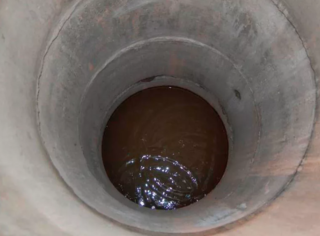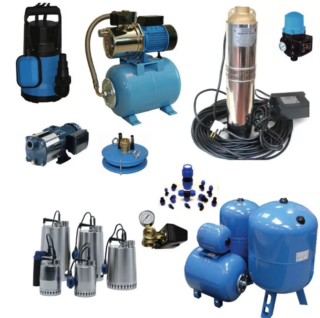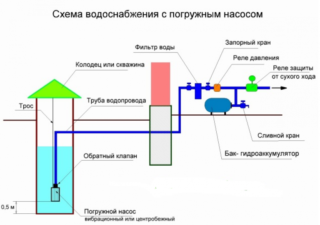Well water supply is one of the options for obtaining water in a house on its own site. This method has its own characteristics and advantages, and the arrangement is seriously different from the drilling of an artesian well. Before choosing such a water supply, it is important to familiarize yourself with all the subtleties.
Features of connecting water from a well

The average depth of any well is 6-10 m, although there are options of greater depth, then they are equipped in the form of a well "on the sand". If we take a height of less than 6 m, melt and rain water that has not passed natural filtration is often found in the ground. A well is a deeper hole in the ground, which in most cases is equipped with a metal pipe and has a higher protection.
Well water tends to contain solid particles that impair the performance of the pumps serving the source. Therefore, when choosing equipment, great importance is attached to the ability to work with impurities. All automatic pumps for supplying water from a well to a house are equipped with a built-in filter and need periodic maintenance.
The main distinguishing feature of water supply to the house from a well is low productivity (on average, 1 cubic meter per hour). In many ways, it depends on the year: the drier it is, the less liquid there will be in the source.
Benefits of water supply from a well
Experts refer to the advantages of the system:
- easy installation - no help from builders and hydrologists is required;
- minimum costs - construction requires 2-3 times less finance than drilling a well;
- access to water even in the absence of electricity;
- less iron and other impurities present in well water;
- the ability to cleanse silt and sand with your own hands;
- the use of inexpensive equipment for pumping water.
Among the disadvantages of this system, one can single out the fact that at a depth of up to 10 m, the water level often jumps, and in dry times it can go so far that the water supply system will work very poorly.
Water supply scheme
- the well to which the equipment is connected;
- pumping station or pump responsible for pumping water;
- storage capacity;
- external and internal water supply;
- water treatment system;
- automatic installation responsible for the operation of the system.
Wells that are drilled at a depth of 30 to 50 m are called “on the sand”. They differ from the purity of artesian springs, but they offer a more filtered liquid than from a simple well up to 10 m deep. Qualitatively different from 10-meter springs is a well with a depth of 20-30 m.
Well location and connection diagram:
- The source is located in the highest place of a summer cottage or private plot.
- The drains from the baths are far away.
- The septic tank is located at least 20 m from the well, as is the cesspool.
- The building that receives the water is relatively close. This is necessary to keep costs down.
It is important to provide for a remote location from the well of such sources of pollution as a drainage field, an open septic tank, a place for walking and keeping livestock or poultry, a vehicle washing area, a vegetable garden where chemical fertilizers are used.
Installation materials and tools

Installation of water supply from a well to a house using a surface or submersible pump will not do without such things as: pipes for internal and external water supply, a saw for cutting pipes, a reliable sealant, the pump itself, as well as filter elements.
Polypropylene and plastic are best suited for organizing the water supply. The diameter depends on the length of the line: if it is more than 30 m, pipes of 32 mm are taken, if from 10 to 30, then 25 mm, when the well is 10 m from the house or less, 20 mm of pipes are enough.
A hydraulic accumulator is another essential thing that prevents the pump from idling and maintains a stable pressure level. Some surface pumping units are equipped with a hydraulic accumulator. They are called pumping stations.
The pump for water supply is selected based on the following parameters:
- Depth. The submersible pump is suitable for working with wells up to 30 m deep, and the surface pump is suitable for providing liquid intake from a depth of up to 10 m.
- Seasonality of operation. It is important that the pump works during the period during which the water supply is planned to be used.
- Water quality. If the liquid in the well is contaminated, the pump must have the appropriate function and the ability to handle impurities.
Surface pumping stations require a stable ambient temperature without strong fluctuations.
Installation of a plumbing system
The installation of the system begins with the wiring inside the house. All pipes and points must be brought into a single network, which is located in the utility room or basement. Equipment is also installed there. Next, the laying of the pipeline begins.
Pipes are laid under the level of soil freezing so that there are no interruptions in the water supply in winter. If the water supply will be used only in summer, it is enough to lay them in shallow trenches or directly on top of the ground.
When implementing a winter water supply, they dig a trench using special equipment and put prepared metal-plastic or plastic pipes on the bottom. To reduce the installation depth, you can use the installation of a heating cable.
One end of the pipe is led out into the well through the shaft, and the other is directed into the house. Further, the holes made are necessarily sealed at all stages of the pipeline. In the well, the pipe should lie 0.5-1 from the bottom, but not more if a surface pump is used. The end must be covered with a mesh filter.
Installation of pumping equipment

Water supply system installation:
- If a submersible pump is used, it is lowered to a depth of 35-50 cm from the bottom of the source, and the nozzle is equipped with a protective filter. A strong cable is used for fastening. The surface pump is installed in a prepared closed room, in which the temperature does not drop below +2.
- A check valve is installed after the pump, which prevents water from flowing back from the collecting tank. In the presence of coarse impurities, a coarse filter is placed in front of the valve.
- In the utility room, a water purification system is installed, selected after consulting a specialist who issued a conclusion on samples from the well. It happens that a full-fledged filtering system is not required, then a fine filter is placed on the pipe in the house.
- To normalize the pressure, a hydraulic accumulator is installed, which collects water and regulates the on / off of the pump.
- A pressure switch and a pressure gauge are installed, the dispensing unit is connected to electricity.
It remains to connect the internal pipes related to the internal water supply system. If hot water is required, the water heater is connected to the water supply in an appropriate place.
Creating a water supply system from a well in a country house or plot is a task that requires care, but not particularly difficult. You can make a water supply system to the house yourself. However, you will have to hire a specialist to analyze the water and possibly a technique to dig a trench.









